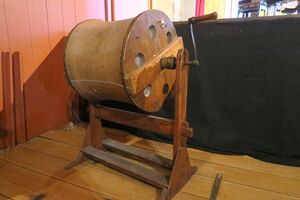The Sounds of Nature
Sound was an important part of the theatre of the Baroque courts. Various ingenious techniques were used to reproduce the sounds of nature, staging storms to thrill and delight the audience.
In the court theatres of the Baroque period, audiences found great pleasure in illusion and surprise. Stage settings could be transformed from one scene to the next in moments, animated by unseen backstage workers (A.04), and lighting, scenery and sound were used together to create a sense of wonder and delight. Effects were used not only to tell the story, but as an entertainment in themselves, in intermezzi – shorter performances such as dances and spectacles between the acts of a play or opera. Representations of nature were popular, such as a scene of a ship at sea in a storm, and a range of techniques were developed to create the sounds of weather: wind, rain and thunder.
The sound of rain could be produced in a variety of ways. Perhaps the simplest was the rain tray – a wooden tray, held with two hands and moved back and forth, filled with dried peas, small shot or even pieces of marble. Sometimes, nails were hammered into the tray so the peas or shot bounced off them as they rolled. Each variation in the technique gave a slightly different quality to the sound. A more complex alternative to the rain tray was the rain box, which comprised a hollow wooden structure containing shot or small peas, mounted on a pivot. Tilting it backwards and forwards made the contents roll from one end to the other, producing the sound of rain. To slow down the movement of the contents, wooden strips or other obstacles were attached to the interior of the box, which functioned in the same way as the nails in the rain tray. A third method was the rain drum (Q126) consisting of a sealed wooden drum containing small shot, lentils, rice or dried peas. The drum was mounted on a rotating axle with a handle to allow the drum to be rotated. When the drum was turned, the contents produced the sound of rain. As before, depending on the desired effect, the drum could be filled with different contents.
Nicola Sabbatini described a method to make the sound of thunder in Practica de Fabricar Scene e Machine ne’ Theatri in 1638 (Q24), in which stones or metal balls were rolled down a slightly inclined wooden trough with steps in it at random intervals, to break up the sound. At the Castle Theatre in Český Krumlov (Q688), the trough is built into the structure of the building at the left-hand side of the proscenium arch, and later theatres had permanent ‘thunder runs’ in the loft space over the auditorium, so the sound of thunder would rumble overhead. To make a ‘crash’ of thunder, rather than a rumble, a large sheet of metal known as a ‘thunder sheet’ or ‘thunder plate’ was suspended, so it could be shaken or hit when the sound was required (Q142).
The sound of wind could be made with a wind machine comprising a rotating drum, similar to the rain drum, but instead of peas inside, it had a strip of fabric such as canvas stretched over its outside (Q160). The drum, rubbing on the fabric, made the noise of a howling wind, rising and falling in tone as the operator increased and decreased the speed of rotation. The example in the City Theatre, Kortrijk (Q644) has what appear to be rope guides on the side of the drum. Their purpose is unclear, but they may have been used to operate the rain drum from a distance, for example when the machine was placed over the stage but controlled from stage level. Another possibility is that two drums were connected together to be worked by a single operator – the rain drum in the same theatre also has rope guides.
The sound of wind could also be made by attaching the ends of thin strips of wood to a cord and whirling it rapidly around in the air. Joseph Furttenbach (Q60) gave details of the technique:
Several thin rulers or pieces of veneer two feet long, three inches wide and no thicker than a knife blade have a small hole the size of a quill at one end where a cord one and three quarters feet long is tied. Someone takes the cord in his hand and swings the ruler with all his might. When many rulers are whirling, they roar like a hurricane.
Furttenbach proposed a remarkable enhancement to the effect, using the audience’s sense of touch as well as hearing: ‘At the same time great bellows may send a wind out through hidden bored holes so that a strong wind actually blows on the audience. This whistling wind with the thunder and lightning, especially if the lights are darkened, will seem like a natural storm.’ The Baroque court theatres used various techniques to create complex soundscapes, which, combined with the elaborate scenery and lighting methods, created scenes of nature to delight and amaze their audiences – a theatre of sensation.



